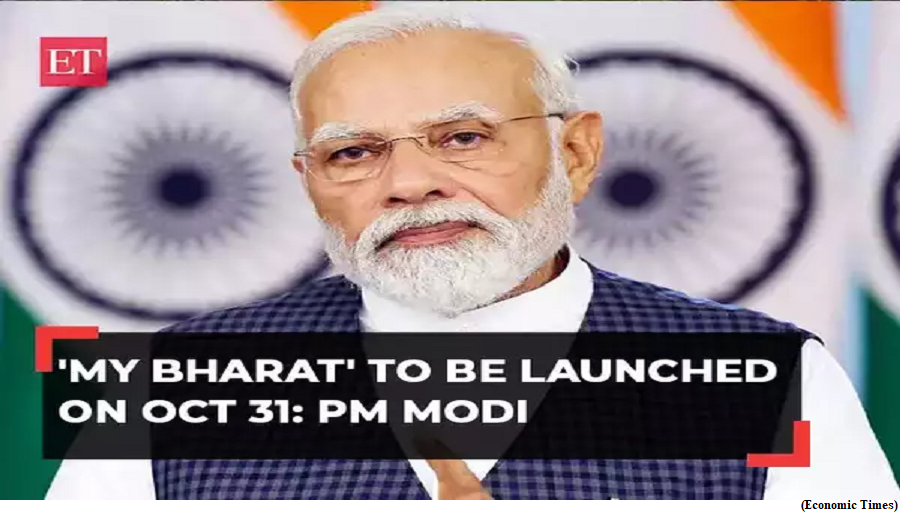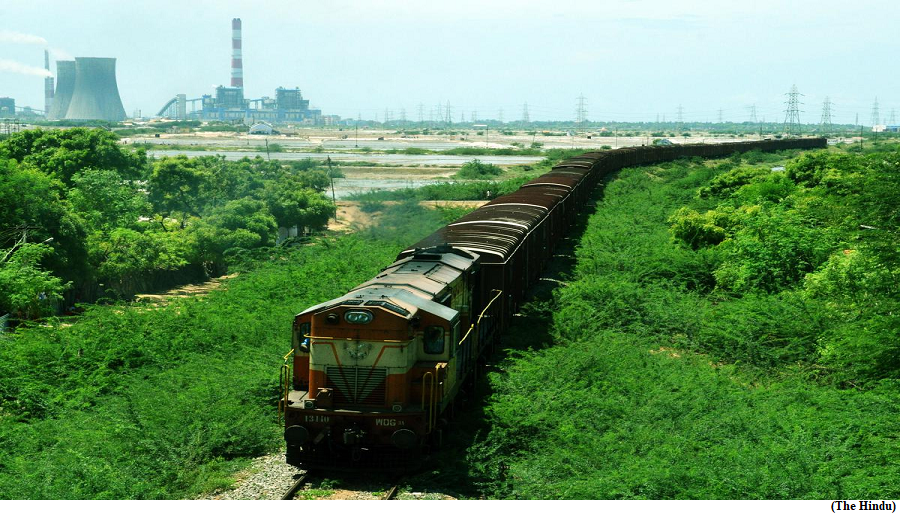Mera Yuva Bharat (MY Bharat) platform launched (GS Paper 2, Governance)

Why in news?
- The Prime Minister recently launched 'Mera Yuva Bharat (MY Bharat)’ platform for youth of the country on October 31st, at Kartavya Path on the National Unity Day.
Vision:
- ‘Mera Yuva Bharat (MY Bharat)’ is envisioned as a pivotal, technology-driven facilitator for youth development and youth-led development, with the overarching goal of providing equitable opportunities to empower the youth in realizing their aspirations and contributing to the creation of a “Viksit Bharat” (developed India), across the entire spectrum of the Government.
- It envisions a framework where the youth of our country can seamlessly connect with programs, mentors, and their local communities.
- This engagement is designed to deepen their understanding of local issues and empower them to contribute to constructive solutions.
Beneficiaries:
- Mera Yuva Bharat (MY Bharat), an autonomous body will benefit the youth in the age group of 15-29 years, in line with the definition of ‘Youth’ in the National Youth Policy.
- The beneficiaries will be in the age-group of 10-19 years.
- Mera Yuva Bharat (MY Bharat) is 'Phygital Platform' (physical + digital) comprising physical activity along with an opportunity to connect digitally.
Significance:
- Role of youth in Amrit Kaal: India’s youth are to play a critical role in defining the future of the nation - especially at the pivotal juncture of India’s 75 years of independence, as the country embarks on a paradigm-shifting development journey over the next 25 years of building an Amrit Bharat by 2047.
- Establishing a framework for bringing youth from diverse areas under a single platform: Vision 2047 requires a framework that can bring rural youth, urban youth and Rurban youth on a single platform. The existing schemes of the Government were designed and launched at different points in time over the last 50 years with the then prevailing understanding of the needs of rural youth in our society. The dynamic shifts in the urban-rural landscape have necessitated a re-evaluation of these approaches.
- Establishing a new contemporary technology-led platform to engage with the present-day youth: In today's fast-paced world, characterized by rapid communication, the prevalence of social media, and the emergence of new digital tools and cutting-edge technologies, a technology-driven platform can connect youth to programmes that can help them improve their capabilities and also connect them with community activities.
- Ensuring accessibility by creating a phygital ecosystem: The Mera Yuva Bharat platform will create a phygital ecosystem and empower young individuals to become catalysts for community transformation. They would act as "Yuva Setu," linking the government with its citizens.
Objectives:
- The primary objective of Mera Yuva Bharat (MY Bharat) is to make it a whole of Government platform dedicated to the advancement of the youth. Its objectives include:
- Improve the leadership skills through experiential learning by shifting from isolated physical interaction to programmatic skills
- Investing in youth to make them social innovators, and leaders in the communities
- Enhanced efficiency through Convergence of existing programmes
- Act as a one-stop shop for young people and Ministries
- Create a centralized youth database
- Improved two-way communication to connect youth government initiatives and activities of other stakeholder that engage with youth
- Ensuring accessibility by creating a Phygital Ecosystem - a blend of physical and digital experiences.
Project Kusha
(GS Paper 3, Defence)
Why in news?
- India is taking steps to develop its own long-range air defence system, similar to the Iron Dome.
- This ambitious venture, named Project Kusha, aims to equip India with a robust air defence system capable of detecting and neutralising incoming threats.
- The Defense Research and Development Organisation (DRDO) in India is spearheading this project, which is scheduled for deployment by 2028-2029.

Project Kusha:
- At the heart of ‘Project Kusha’ is the development of India’s very own Long-Range Surface-to-Air Missiles (LR-SAM) that, is comparable to Russia’s S-400 Triumf air defence system.
- Jointly developed with Israel Aerospace Industries, Israel’s major aerospace and aviation manufacturers, Kusha was greenlit by the Cabinet Committee for Security in May 2022.
- It was accorded Acceptance of Necessity (AoN), the first step toward procurement of any military equipment and hardware by the Defence Ministry for procuring five of its squadrons for the IAF for Rs 21,700 crore.
Key features of indigenous LR-SAM system:
- The mobile LR-SAM, with its long-range surveillance and fire control radars would have different types of interceptor missiles designed to hit hostile targets at 150 km, 250 km, and 350 km ranges.
- Meant to provide comprehensive air defence cover to strategic and tactical vulnerable areas, the system can take out “fighter-sized” targets at a range of up to 250 km and larger aircraft at 350 km.
- It is also capable of “reliable area air defence” with a single-shot kill probability of not less than 80 percent for a single missile launch and not less than 90 percent for salvo launch.
- The S400 can take down long, medium, and short-range threats, Project Kusha aims at the development of only long-range air defence.
IACCS:
- The LR-SAM system will be also made capable of interacting with an integrated command and control system (IACCS).
- The IACCS is an automated air defence command and control centre that the Indian Air Force uses for controlling and monitoring air operations.
Other projects:
- But LR-SAM isn’t the only project India is developing with Israel.
- India’s Kalyani Strategic Systems has already entered a joint venture with Israel’s Rafael Advanced Systems Ltd for indigenous production of MRSAM, some of which have already been procured by the IAF.
- The IAF has already inducted some Medium-Range Surface to Air Missile (MRSAM).
Defence against regional threats:
- One of the primary security concerns for India is its neighbouring countries, particularly China.
- China is reported to have deployed several missile batteries across the Indo-Tibetan border, known as the Line of Actual Control (LAC).
- The ability of China to launch missiles at India and force the Indian Air Force to invest substantial time and resources in neutralising these threats stresses on the need for high-tech and precision-guided air defence systems.
How cargo transport can be improved
(GS Paper 3, Infrastructure)
Context:
- Analysis of the carriage of non-bulk and general cargo by the Indian Railways (IR).

Details:
- In 2018-19, before the onset of COVID-19, the IR loaded 62 million tonne (MT) of general cargo consisting of 45 MT of general goods, 12 MT of domestic containers and 5 MT of parcels, earning a total of ₹8,247 crore with the average earnings per tonne being ₹1,339 for goods and ₹3,384 for parcel.
- However, general cargo loading is nowhere near what a Rail India Technical and Economic Service (RITES) study had projected in 2008 for the next ten years, between 194 to 292 MT depending on the IR’s efforts.
Move for general cargo:
- The IR’s current strategy for moving general cargo is two-pronged, the parcels are moved either by passenger trains or special heavy parcel van (VPH) trains.
- However, these approaches appear to have gone haywire as loading leased parcel vans and full parcel trains fell by 15% and 8% respectively.
Why VPH parcel trains are proving counterproductive?
- One of the reasons for the decline in the parcel segment is the high tariff; an analysis of 15 origin to destination pairs indicates that both premium (P) scale rates and Rajdhani (R) rates, after adding the first and last mile costs, are higher than truck rates, an exception being cargo moved to destinations in the northeast.
- Other factors are improper terminals, inconsistent weighbridges intensified by excessive penal charges, unreliable transit times, complex booking and delivery mechanisms and self-imposed environmental restrictions.
- A matching covered wagon (more technically a Covered Bogie Wagon Type with Air Brake and Heavy Load (BCNHL)) carries 700% more cargo with 45% more volume.
- Even if the P scale rates are reduced by half, the revenue generated would be 3.5 times that of the VPH rake.
Inadequacy of containerization:
- Another great hope for the IR was the expected fillip to general cargo movement by private container train operators (CTOs) through containerisation.
- However, after 15 years of privatisation, domestic cargo moved by containers is a mere 1% of the IR’s loading and 0.3% of the total freight in the country. High haulage rates is one of the reasons of such under-performance.
- The problem perhaps also lies in the risk involved in developing the market as it would inevitably involve losses over a period of time. Furthermore, sustaining a developed market is also difficult as predatory pricing by other CTOs can wean the market away.
- The elephant in the room for carriage of general cargo by the IR is that a shipper can either only send a few tonnes under parcel tariff or thousands of tonnes under freight tariff.
- General cargo has thousands of buyers and sellers and usually their shipment sizes are a few to hundreds of tonnes.
- The IR is therefore, not their choice as it has no service to meet their needs. Asking these shippers to book a freight train is akin to asking a passenger travelling by the Rajdhani express to come with a load of passengers before a berth is booked.
Future Roadmap:
- General cargo is segmented into three categories: highly time sensitive (HTSG), medium time sensitive (MTSG) and low time sensitive (LTSG).
- HTSG cargo is mostly valuable goods or perishables and they should continue to be moved by passenger trains. Attaching two to three parcel vans in all popular trains would easily double the parcel loading capacity and these parcel vans can bring around five times the revenue of sleeper coaches and around two times that of AC coaches.
- MTSG and LTSG cargo are price-sensitive and this cargo should be moved under the IR freight rates, which are lower than truck rates. Even after the addition of first and last leg costs there is a cost-benefit to shippers. However, the problem lies in getting a full train load.
- Shippers should be permitted to book individual wagons with provision to run a train to the schedule even if the train is not fully loaded. The assurance of timely movement would certainly attract shippers to the IR.
- Running such freight trains does not require any change in policy, only change in mindset. Tweaking of freight tariff rules would be required by adding freight of any kind (FAK) for wagon loads to the tariff table. Indents for a single wagon should be encouraged.
- To incentivise volumetric loading, tariff may also be moderated by increasing charges in slabs as per quantity loaded.
Way Forward:
- Finally, the IR needs to encourage cargo aggregators by tweaking the existing freight forwarder policy. In the long run new kinds of stocks to optimise pay load and speed would also be required which the IR and the rolling stock industry are fully capable to design and deliver.




